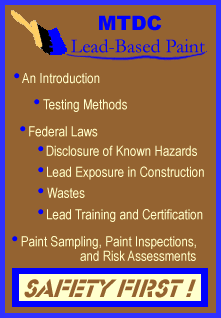 |
 |
Technology & Development Center |
| May 1997 | 7100 | 9771-2319-MTDC |
Andy Trent, Project Leader, and
Bev Young, Environmental Engineer
This is the seventh in a series of Tech Tips dealing with lead-based paint. This Tech Tip describes the requirements for training and certifying individuals and firms who conduct lead-based paint inspections, risk assessments, and abatement services in residences and facilities occupied by children.
In August 1996, the Environmental Protection Agency (EPA) issued new regulations (40 CFR Part 745, Requirements for Lead-Based Paint Activities in Target Housing and Child-Occupied Facilities) to prevent and reduce lead exposures among younger children. The EPA requires that individuals and firms conducting lead-based paint inspections, risk assessments, and abatement activities in target housing and facilities occupied by children have training, be certified, and follow work practice standards beginning September 1, 1999.
This rule establishes five categories of lead-based paint professionals:
Training courses (2 to 5 days long), competency exams, and periodic refresher classes will allow the lead-based paint professionals to conduct the following activities:
Since this rule focuses on lead exposure among young children, it is limited to these buildings:
The rule specifically outlines standards for conducting inspections, risk assessments, abatement, and clearance sampling after abatement (40 CFR Part 745.227). Certain abatement practices are prohibited, such as open-flame burning, machine sanding or grinding, sandblasting, and dry scraping of lead-based paints.
The exclusions from this rule are as noteworthy as the requirements. This rule does not mandate that inspections, risk assessments, or abatements be conducted in target housing and child-occupied facilities. The rule merely requires that if these activities are conducted, they must be done by individuals who have been appropriately trained and certified. The EPA has limited the scope of abatement to those activities that permanently eliminate lead-based paint hazards. Renovation and remodeling are not covered by this rule because they are not specifically designed to eliminate a lead-based paint hazard. The EPA is considering future protective requirements for these activities since remodeling and renovation can disturb lead-based paint or create new hazards.
When originally proposed, this rule would have applied to most public and commercial buildings and steel structures. Commercial buildings, superstructures, bridges, and public buildings other than child-occupied facilities are currently exempt from this rule, although future regulations may require trained and certified contractors for these facilities. Homeowners are exempt when they are working in a residence they own and occupy.
Full details on this regulation can be obtained from the National Lead Information Center (phone: 1-800-424-LEAD).
The Department of Housing and Urban Development has established the Lead Listing (phone: 1-888-532-3547), a centralized listing of contractors and individuals who have received training from an accredited provider.
You may also contact the EPA Regional Office closest to your area for additional information on state contractor certification and licensing programs:
Andy Trent is a mechanical engineer at MTDC.
Bev Young is an environmental engineer at the Forest Service's Northern Regional Office in Missoula.
 Lead-Based Paint: Paint Sampling, Paint Inspections, and Risk Assessments will describe the differences between lead-based paint sampling, paint inspections, and risk assessments.
Lead-Based Paint: Paint Sampling, Paint Inspections, and Risk Assessments will describe the differences between lead-based paint sampling, paint inspections, and risk assessments.
USDA Forest Service
Missoula Technology & Development Center
5785 Highway 10 West
Missoula, MT 59808-9361
Phone: (406) 329-3900
Fax: (406) 329-3719
For further technical information, contact Andy Trent at the address above.
Phone: (406) 329-3912
Fax: (406) 329-3719
DG: A.Trent:R01A
E-mail:atrent@fs.fed.us
The Forest Service, United States Department of Agriculture (USDA), has developed this information for the guidance of its employees, its contractors, and its cooperating Federal and State agencies, and is not responsible for the interpretation or use of this information by anyone except its own employees. The use of trade, firm, or corporation names in this document is for the information and convenience of the reader, and does not constitute an endorsement by the Department of any product or service to the exclusion of others that may be suitable. The U.S. Department of Agriculture (USDA) prohibits discrimination in all its programs and activities on the basis of race, color, national origin, age, disability, and where applicable, sex, marital status, familial status, parental status, religion, sexual orientation, genetic information, political beliefs, reprisal, or because all or part of an individual’s income is derived from any public assistance program. (Not all prohibited bases apply to all programs.) Persons with disabilities who require alternative means for communication of program information (Braille, large print, audiotape, etc.) should contact USDA’s TARGET Center at (202) 720-2600 (voice and TDD). To file a complaint of discrimination, write to USDA, Director, Office of Civil Rights, 1400 Independence Avenue, S.W., Washington, D.C. 20250-9410, or call (800) 795-3272 (voice) or (202) 720-6382 (TDD). USDA is an equal opportunity provider and employer.
|
| Top |
| USDA Forest Service, Technology and Development Last Modified: 10/15/2016 23:43:34 |